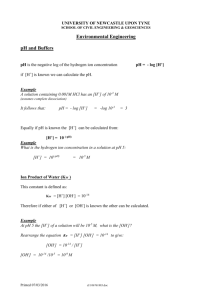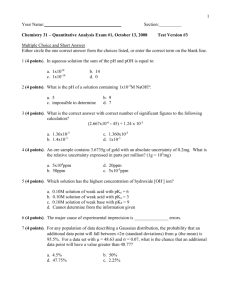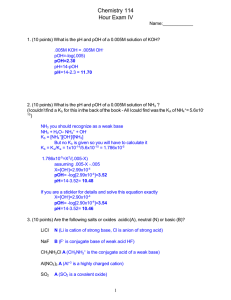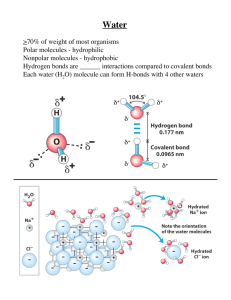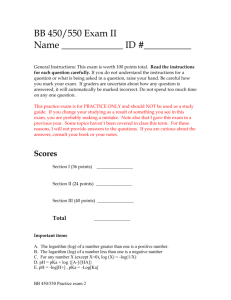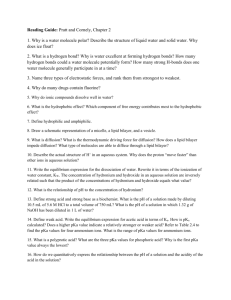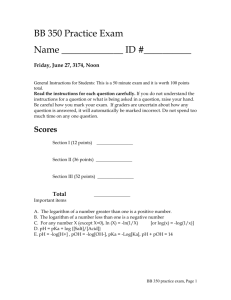FCH530 Homework1ans
advertisement
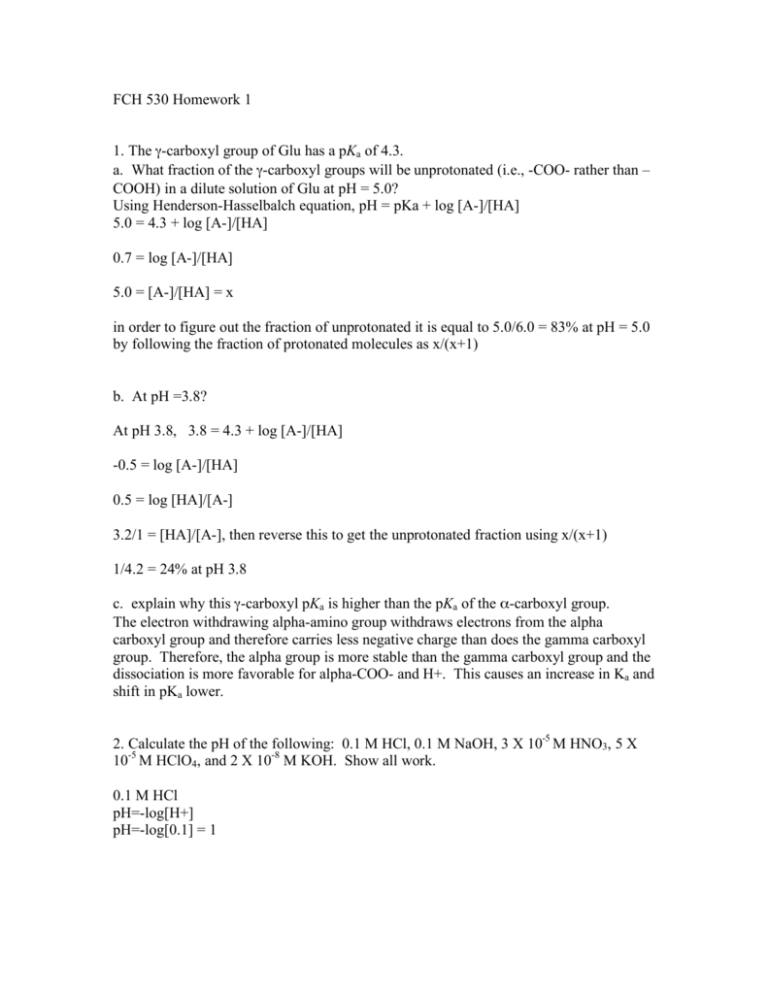
FCH 530 Homework 1
1. The γ-carboxyl group of Glu has a pKa of 4.3.
a. What fraction of the γ-carboxyl groups will be unprotonated (i.e., -COO- rather than –
COOH) in a dilute solution of Glu at pH = 5.0?
Using Henderson-Hasselbalch equation, pH = pKa + log [A-]/[HA]
5.0 = 4.3 + log [A-]/[HA]
0.7 = log [A-]/[HA]
5.0 = [A-]/[HA] = x
in order to figure out the fraction of unprotonated it is equal to 5.0/6.0 = 83% at pH = 5.0
by following the fraction of protonated molecules as x/(x+1)
b. At pH =3.8?
At pH 3.8, 3.8 = 4.3 + log [A-]/[HA]
-0.5 = log [A-]/[HA]
0.5 = log [HA]/[A-]
3.2/1 = [HA]/[A-], then reverse this to get the unprotonated fraction using x/(x+1)
1/4.2 = 24% at pH 3.8
c. explain why this γ-carboxyl pKa is higher than the pKa of the α-carboxyl group.
The electron withdrawing alpha-amino group withdraws electrons from the alpha
carboxyl group and therefore carries less negative charge than does the gamma carboxyl
group. Therefore, the alpha group is more stable than the gamma carboxyl group and the
dissociation is more favorable for alpha-COO- and H+. This causes an increase in Ka and
shift in pKa lower.
2. Calculate the pH of the following: 0.1 M HCl, 0.1 M NaOH, 3 X 10-5 M HNO3, 5 X
10-5 M HClO4, and 2 X 10-8 M KOH. Show all work.
0.1 M HCl
pH=-log[H+]
pH=-log[0.1] = 1
0.1 M NaOH
pH=-log[H+]
we know that [H+]*[OH-]=1.0 * 10-14
so, [H+]=1.0 * 10-14/[OH-] = 1.0 * 10-14/[0.1M]= 1.0 * 10-13
therefore, pH =-log[1.0 * 10-13] = 13
3 X 10-5 M HNO3
strong acid so pH = -log [H+] = -log[3 X 10-5 M] = 4.523
5 X 10-5 M HClO4
pH=4.301
2 X 10-8 M KOH
This number is smaller than the concentration of OH- in water from the equation above
[H+]*[OH-]=1.0 * 10-14 in water and [H+]=1.0 * 10-7 and [OH-] = 1.0 * 10-7. Because
the concentration contributed by KOH is lower than concentration of [OH-] in water, we
must take this into consideration.
KOH = [2 * 10-8 M K+] + [2 * 10-8 M OH-]
H2O= [x M H+] + [x+2 * 10-8 M OH-] (unknown)
x{(2 * 10-8 +x)}= 1.0 * 10-14
x2 + 2 * 10-8x -1.0 * 10-14 = 0, solve for x using the
quadratic equation
x= [-2 * 10-8 + ((2 * 10-8)2-4(1)(-1.0 * 10-14))1/2]/2(1)
you will get two answers. x=9.04 * 10-8 will give you a pH of 7.04 if you plug it in.
3. Draw the structures, full names, three-letter names, and 1-letter symbols for all 20
amino acids.
See Table 4-1 in Voet and Voet Biochemistry
4. Draw 4 equivalent Fischer projection formulas for L-alanine.
5. For the dipeptide Glu-Ala write out the structure and estimate the pK of all ionizable
groups.
pKa~4.07
-O
O
O
NH3
N
+H
pKa~9.47
OO
pKa~2.10
Using your assigned pK values, determine the net charge at pH 1, 3, 5, 7, 10, 11
pKa
Alpha
2.10
amino
pKa
Side
4.07
chain
carboxy
pKa
Alpha
9.47
carboxy
pKa
Net
charge
Charge
pH 1
pH2
0
0 to 1/50%
pH3
-1
pH4
-1
pH5
-1
pH7
-1
pH10
-1
pH11
-1
0
0
0
0 to -1
50%
-1
-1
-1
-1
+1
+1
+1
+1
+1
+1
0
0
+1
+1
0
0
-1
-1
-2
-2
Calculate the pI
(2.10 + 4.07)/2=3.09
6. Write a table describing the main differences between gram-positive and gramnegative bacteria?
Gram-positive
Gram-negative
Thick peptidoglycan layer
Thin peptidoglycan layer
Single membrane
Inner and outer membrane
No periplasm
Periplasm
7. Write a table summarizing the main differences between prokaryote and
eukaryote cells
Prokaryotes
Eukaryotes
Bacteria, Archae
Fungi, protests, animals, plants
1-10 µm
10-100 µm
No nucleus
Nucleus
8. The dipeptide Ala-His
N
N
O
N
+H
NH3
OO
alanylhistidine
9. The tripeptide Glu-Pro-Cys
OO
O
O
-O
SH
O
HN
N
NH3
+
10. Show how an oligopeptide of Leu and Lys can be either a branched-chain or a
straight-chain structure (only straight-chain structures occur in most natural
proteins).
NH3+
NH3+
O
N
+H
NH3
H
N
O
N
H
O
OO
leucinyllysinylleucinyllysine
O
NH3+
HN
NH3+
O
N
+H
NH3
H
N
O
O
N
H
branch from the lysine groups
OO
